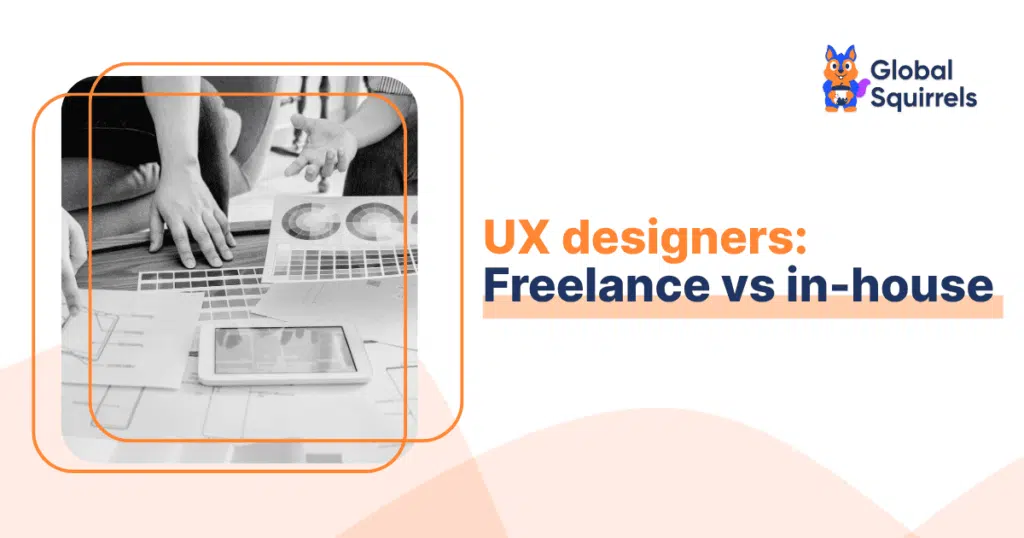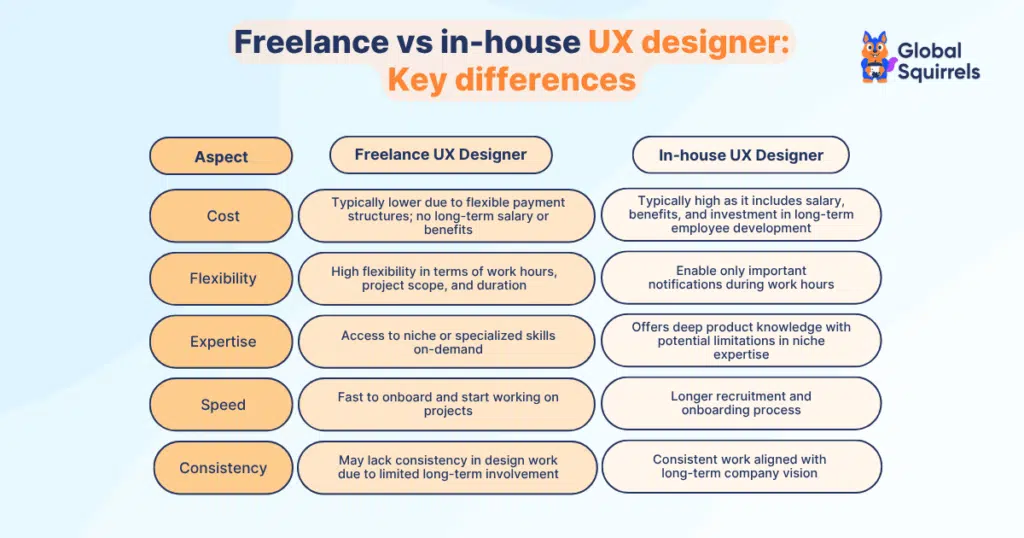Freelance UX designers vs. in-house: Which is right for your project?

When you are building a product or trying to improve a digital experience, a great design isn’t an option; it is vital. However, before wireframes and user flows come into play, an important decision to make includes whether you should hire a freelance UX designer or hire someone in-house.
It is a question most startups, growing businesses, and agencies have to deal with. Freelancers tend to offer flexibility and speed, while in-house designers will bring deep product alignment and continuity. Every option accompanies its own set of benefits and potential drawbacks. In this blog, we will explore both options to help you choose the correct UX talent model for the project, timelines, and team.
What does a UX designer do?
A UX or user experience designer will focus on how the users will interact with the product, such as the app, software, and website. They have to ensure that the experience is smooth, enjoyable, and useful.
The key responsibilities include:
1. Understanding the user:
- Research what the users are expecting, requiring, and struggling with
- Conduct interviews, usability testing, or surveys
2. Planning the user journey:
- Mapping out how the users move through the product
- Identifying where they get confused or stuck
3. Creating prototypes and wireframes:
- Sketching or building early versions of pages or screens
- Show the flow, key actions, and layout
4. Improving and testing the design:
- Get real user feedback
- Tweak the designs based on what is working
5. Collaborating with designers and developers:
- Working closely with UI developers, product managers, or designers
- Making sure that the final product will match the user’s goals and business needs
6. Ensure accessibility and usability:
- Make sure the design works well for everyone, which includes people with disabilities
- Focusing on clear navigation, functionality, and readability.
Job description template for a UX designer
A UX designer plays an important role in shaping the way users interact with the digital product. Crafting a clear and comprehensive job description is crucial for attracting top-tier talent who can contribute to creating an exceptional user experience. If you are wondering how to hire a UX designer, an effective job description is important.
An important thing to note is that the job descriptions for a full-time employee and a freelancer will differ significantly, reflecting the fundamental differences in their employment relationship, responsibilities, and benefits.
Here’s an example of a job description for a freelance UX designer:
We are looking for a freelance UX designer to join the team. You will be working closely with the product and development teams to create an engaging, user-friendly experience across digital products. You will be responsible for understanding the user needs, designing prototypes and wireframes, conducting research, and ensuring that the final design aligns with the goals and the brand.
The responsibilities include:
- Conducting user research and gathering insights to inform design decisions
- Create the user personas, wireframes, and user journeys that outline the design workflows and concepts
- Designing interactive prototypes and mockups for mobile and web applications
- Collaborating with developers to ensure designs are implemented as quickly as possible
- Performing usability tests and gathering feedback to improve the designs
Advantages of hiring a freelance UX designer
There are several clear benefits to hiring a freelance UX designer, particularly for companies that want top-notch design work but lack the funds or time to hire a full-time employee. Here, we’ll examine the main advantages:
1. Affordable talent:
Hiring a freelance UX designer is often way more affordable than hiring a full-time employee. You can avoid costs like:
- Monthly salary
- Health benefits
- Retirement contributions
- Paid time off and insurance
Freelancers will often work on an hourly or project-based rate, therefore making it easier for small businesses and startups to manage costs without sacrificing the design quality.
2. Flexible work arrangement:
One of the biggest advantages of freelance UX designers is flexibility. You can:
- Hire them only when you require them
- Scaling up and down based on the workload
- Bringing in niche experts for specific design challenges
This is especially valuable for companies with irregular design needs or seasonal workloads.
3. Faster onboarding and turnaround:
Unlike full-time hiring, freelancers are often ready to start within a few days. This makes them suitable for:
- Strict deadlines
- Emergencies in design
- Product demos and pitch decks
- MVPs
4. Access to special skills:
Freelance UX designers will often work across multiple product types and industries, which gives them:
- Exposure to multiple platforms, UX methodologies, and tools
- Experience solving a wide range of design problems
Therefore, you can hire someone with exactly the skill set that is required without any long-term commitment.
5. Fresher perspective:
Because freelancers work with diverse clients, freelancers can bring:
- A new lens on the product
- Unbiased feedback
- Ideas you may not get from an in-house team that’s too close to the project
Challenges of hiring a freelance UX designer
Although employing a freelance UX designer might provide flexibility and specialized knowledge, it’s crucial to consider the challenges before choosing one. Some of them include:
1. High wire transfer fees:
When hiring a freelance UX designer from multiple countries, businesses often tend to face high wire transfer fees and fluctuating currency rates. These international payment transactions could lead to certain unexpected costs. These fees could add up over time, thus impacting the overall project budget. Moreover, some freelancers could use payment methods that incur extra traditional fees, which also complicates the financial side of the project.
2. Lack of commitment:
Freelancers are not full-time employees, which can lead to concerns about their commitment to the project. However, unlike in-house designers, freelance UX designers can end up dividing their attention across various clients, therefore causing delays in the project. Additionally, the nature of functioning may also mean that freelancers will have less emotional investment in the company.
3. Compliance with labor laws:
Hiring a freelance UX designer, especially across borders, will raise compliance issues related to labor laws, intellectual properties, and taxation. International freelancers may not be subject to the same labor laws, which could expose businesses to legal risks, including non-compliance, as well as tax reporting requirements or issues related to ownership of designs.
Related read: What is W-8 Ben form?
Advantages of in-house UX designers
Having a UX designer on staff might have major benefits when it comes to creating a user-centric product that freelancers might not be able to provide. The main advantages of employing a UX designer internally are given below:
1. Detailed understanding of the product:
In-house designers will work closely with the team every day. They:
- Gain deep information about the users, products, and business goals
- Make more informed design decisions
- Thinking long-term and not just project-to-project
This will result in more strategic and consistent user experiences over time.
2. Cross-functional collaboration:
Being part of the internal team allows for:
- Real-time communication with PMs, marketers, and developers
- Easy participation in team stand-ups and agile sprints
- Faster iteration cycles and better teamwork
This level of collaboration is generally hard to replicate with freelancers.
3. Consistency in design systems:
Usually, in-house designers could:
- Build and maintain the design systems
- Ensure visual and UX consistency across all the platforms and screens
- Evolve the product in sync with the brand
This consistency often leads to a strong and more scalable user experience.
4. Long-term commitment:
Full-time UX designers are known to be invested in the company’s success. They tend to:
- Own and improve the product over time
- Retain the institutional knowledge
- Become highly efficient as they grow along with the team
This long-term thinking is important for products that are continuously evolving.
5. Quick decision-making:
Since the in-house designers are available full-time:
- There is less back-and-forth
- The feedback loops are way shorter
- Design updates can be made quickly
This is especially helpful in fast-paced environments.
Challenges of hiring an in-house UX designer
Compared to hiring freelancers, hiring full-time designers may be more expensive, involve a longer hiring process, and offer less flexibility. Among the possible drawbacks are:
1. Longer hiring process:
The top UX talent is in the highest demand. Finding the right in-house candidate could take:
- Multiple weeks or even months
- Internal recruiter involvement and resources
- Time to evaluate culture fit and design skills
This could delay the critical projects.
2. High retention risks:
If the in-house designer leaves:
- You could lose key product knowledge
- The hiring process should start over
- Ongoing design projects could come to a halt
This is especially significant if they are the only UX designers in the business.
3. High markups when hired through a staffing agency:
One of the common challenges of hiring an in-house UX designer through a staffing agency is the high markups that are often associated with the service. Staffing agencies charge:
- Designer’s base pay
- Operational costs
- Profit margins
- Recruitment fee
This could greatly increase the final cost of hiring a full-time UX designer.
When to choose between a freelance and an in-house UX designer?
Choosing the correct type of UX talent often depends on more than just the budget or availability. Before you commit, evaluate the key factors to make sure your investment delivers long-term value and immediate results.
1. Scope of the project and duration:
The duration and scope of the project are important in determining the best option.
- If the project is short-term, a freelancer could be the correct fit. They are also quick to hire and can easily handle isolated tasks effectively.
- However, if the project needs any ongoing updates or long-term product development, such as large-scale product launches, user research, etc, an in-house designer will provide an in-depth investment in the product and long-term consistency.
2. Budget-based limitations:
While both freelancers and in-house hires have their costs, the financial expectations can differ:
- Freelancers are usually more cost-effective for project-based or short-term work since you can also avoid benefits, overhead costs, and salary commitments.
- In-house designers expect a higher investment, like training, benefits, equipment, and salaries, but also offer better value for work.
3. Hiring speed:
When it comes to speed, freelancers have an edge:
- Freelancers can typically hire in a matter of days. This is especially ideal if you require immediate help with a deadline or project.
- Hiring an in-house designer could take months or weeks, depending on the job market, competition, and recruitment process.
4. Access to special skills:
If the project requires highly specialized design skills like mobile-first design, user research, or SaaS onboarding, freelancers can offer access to a wide, global talent pool of experts.
- Freelancers will have experience across various industries and can bring fresh perspectives, tools, and techniques that an in-house team could lack.
- In-house designers may have a deep understanding of the product and a closer connection to the company’s culture, thus making them a better choice for ongoing and internal design needs.
5. Growth and scalability plans:
If you are building a product with plans for future growth, consider how scalable every option is:
- Freelancers are flexible and allow you to scale quickly, especially if you need additional help on demand for certain design phases.
- However, the in-house designers will be mainly committed to the brand and its long-term vision, thus allowing for great design as the product expands.
Read more: Ultimate guide to hiring and managing freelancers effectively
What is the typical salary of a UX designer across countries?
This depends on various factors, such as where you are hiring from (cost of living), the level of experience, labor laws, and more. Here are a few examples of how much a UX designer typically would demand if you are hiring across borders:
- India: $11,697 – $23395/year
- Philippines: $6264 – $6696/year
- Mexico: $23,072 – $37,812/year
Source: Glassdoor
How can Global Squirrels help in overcoming the challenges?
Global Squirrels is a staffing and payrolling SaaS platform that helps companies find and hire freelancers and full-time employees. Additionally, we also manage all the HR functions such as contracts, compliance, timely payments, and performance management.
1. No need to pay the wire transfer fee:
As an Employer of Record, Global Squirrels has established entities in Mexico, India, the Philippines, and numerous other countries, which are recognized as top hubs for hiring affordable talent. Through our EOR services, we take care of the entire payroll process, thus eliminating the need for businesses to pay the costly wire transfer fees. This streamlined approach ensures that the payments are processed efficiently and smoothly without any administrative burden.
2. Proper documentation to ensure commitment:
Global Squirrels helps companies mitigate risks that are associated with the offer letter or agreement, which ensures that the contractor or full-time talent works on the project. Their documents will clearly define the scope of work, company formalities, exit formalities, etc. This, in turn, ensures zero risks to the company.
3. Compliance-related issues:
Hiring internationally involves various complex issues. This is especially true since labor laws, tax regulations, and benefit requirements are constantly changing. Global Squirrels handles the payroll for talents working across borders, tax deductions, and statutory benefits. Therefore, they ensure full compliance in multiple locations.
4. Quick hiring process:
Global Squirrels finds the right UX designer by screening profiles based on business requirements. We use intelligent matching algorithms to connect the company with designers who rightfully align with the brand’s vision, design style, and requirements. By pre-screening candidates based on their skills and past work experience, we ensure you have access to qualified talent, thereby saving you time, effort, and the uncertainty of hiring the wrong fit.
5. No agency fees:
While most staffing agencies charge high markup fees or commissions for hiring talent, Global Squirrels will only require you to pay the freelancer’s hourly pay and a flat license fee. Similarly, when hiring full-time employees through agencies, businesses often incur additional costs, such as administrative fees and agency charges, in addition to the talent’s base salary. At Global Squirrels, we streamline the process by only charging for payroll and platform fees, which can help you save up to 30% on your hiring costs.
How can you leverage our Orange and Purple plans to hire and manage UX designers?
The Orange Employee Plan will ensure you find and hire the right talent who will meet all the requirements. Through this plan, you may find a candidate to work remotely or from your office. Once you sign up for our platform and choose the Orange plan, fill in the details like budget, job title, job description, expected start date, skills, and educational background. You will receive curated profiles within 2-5 business days. You can select your preferred candidates and choose between three interview time slots. After the interview, you will receive an email requesting you to provide feedback. Once the decision is made, our platform will start the onboarding process and take care of the HR functions such as onboarding, payroll, compliance, and performance management.
On the other hand, the Purple Employee Plan will allow you to onboard a self-sourced employee. Our staffing platform will take care of the onboarding and administrative functions, such as offer letter generation, tasks and timesheets management, performance management, and payroll and benefits.
For the Orange Freelancer Plan, the process remains consistent, where we will hire a freelance UX designer for your company. However, the key distinction lies in the payment structure, as the freelancer will be compensated on an hourly basis. Despite this change, we will continue to manage essential aspects such as performance management, onboarding, compliance, and timesheet tracking, ensuring a seamless experience for both you and the freelancer.
Similarly, under the Purple Freelancer Plan, you will source the resources and send them to us to initiate the onboarding process. In this plan, freelancers will be compensated on an hourly basis. We will continue to manage performance tracking, compliance, and timesheet monitoring to ensure a smooth and efficient experience.
Get to know more about the hiring process for UX designers. Request a demo!

